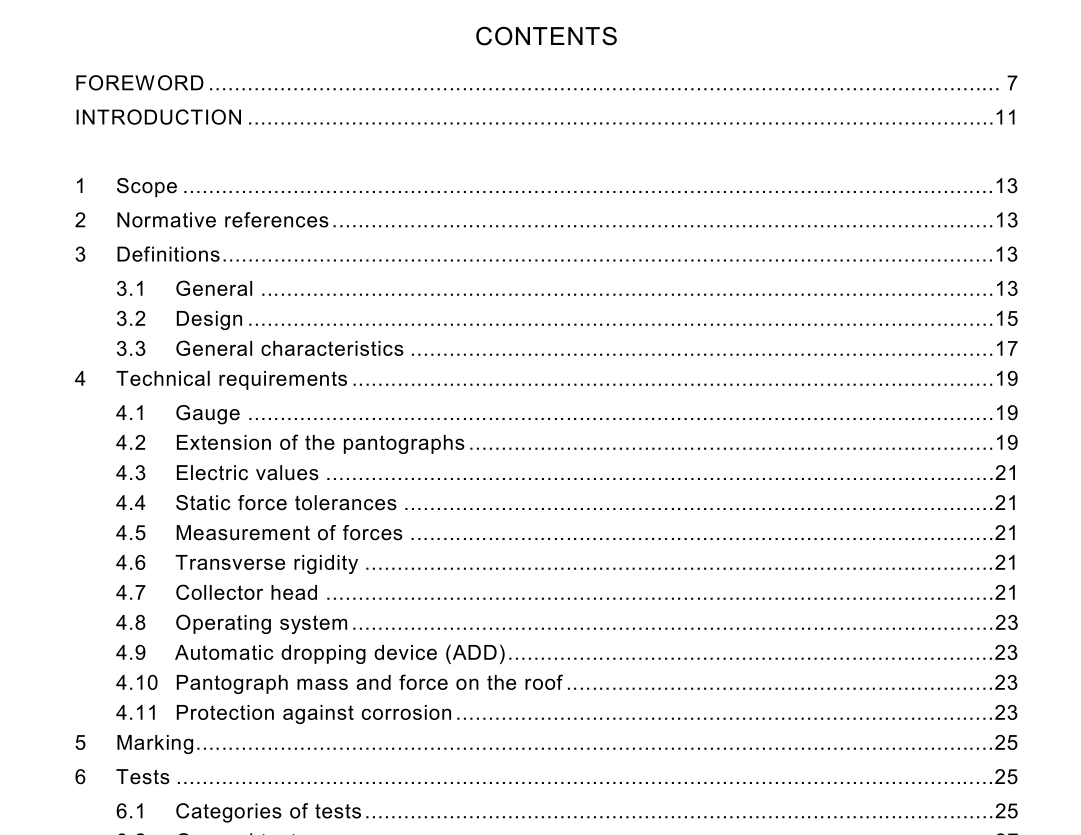IEC 60494-1 pdf download

IEC 60494-1 pdf download.Railway applications – Rolling stock – Pantographs – Characteristics and tests
1 Scope
This part of IEC 60494 defines the general assembly characteristics which are to be applied to pantographs for main line vehicles, to enable current collection from the overhead line system. It also defines the tests the pantographs have to perform, excluding insulators. This standard does not apply to pantograph dielectric tests, which are to be performed on the pantograph installed on the vehicle roof. This standard does not apply to pantographs used on isolated metros and light rail systems: these pantographs are considered in IEC 60494-2.
3 Definitions
For the purposes of this part of IEC 60494, the following definitions apply; for the definitions of general terms used, reference should be made to IEC 60050-811. 3.1 General 3.1.1 supplier manufacturer of the pantograph 3.1.2 customer either the operating authority or the vehicle manufacturer 3.1.3 pantograph (see annex A) apparatus that collects current on one or more contact lines. It consists of a base frame, an operating system, a frame and a collector head. It is of variable geometry. In the “operating” position, the apparatus is entirely or partly under voltage. It is electrically insulated only at its interfaces, on the vehicle roof. It enables current to be transmitted from the overhead line to the vehicle electrical system 3.2 Design The following definitions are related to figure A.1, except for items 9, 15, 16, 17, 18. 3.2.1 frame (item 1) articulated structure which enables the collector head to move in a vertical direction with respect to the base frame of the pantograph 3.2.2 base frame (item 2) fixed part of the pantograph which supports the frame and is mounted on insulators fixed to the vehicle roof 3.2.3 collector head (item 3) part of the pantograph supported by the frame which includes contact strips, horns and may include a suspension 3.2.4 contact strip (item 4) replaceable wearing part of the collector head which interfaces with the overhead line 3.2.5 horns (item 5) ends of the collector head which ensure smooth engagement with the contact wire 3.2.6 collector head length (item 6) dimension of collector head measured horizontally transversely in relation to the vehicle 3.2.7 collector head width (item 7) dimension of collector head measured longitudinally in relation to the vehicle 3.2.8 collector head height (item 8) the vertical distance between the lowest point of the horns and the upper most point of the contact strips 3.2.9 collector head pivot (item 9) it is the pitching axis of the collector head, if any pivot is applied 3.2.10 length of contact strips (item 10) the total length measured transversely in relation to the vehicle 3.2.11 height at “lower operating position” (item 11) vertical distance between the pantograph mounting plane on the top of insulators and the upper surface of contact strips, the pantograph being raised to the lowest level at which it is designed to collect current 3.2.12 height at “upper operating position” (item 12) vertical distance between the pantograph mounting plane on the top of the insulators and the upper surface of the contact strips, the pantograph being raised to the highest level at which it is designed to collect current 3.2.13 working range (item 13) difference between the “upper operating position” height and the “lower operating position” height 3.2.14 housed height (item 14) vertical distance between the pantograph mounting plane on the top of insulators and the upper surface of the contact strips or any other part of the pantograph structure if higher (pantograph being in the housed position) 3.2.15 pantograph “electrical thickness” (item 15) vertical distance between the highest live part and the lowest live part of the pantograph at housed position 3.2.16 operating system (item 16) device which provides a force to raise or to lower the pantograph 3.2.17 maximum extension (item 17) maximum extended height to mechanical stops (without any device which will limit the pantograph extension within the working range) 3.2.18 limited maximum extension (item 18) reduced extension allowed by intermediate mechanical stops 3.3 General characteristics All general characteristics are defined in the customer specifications. Unless otherwise specified, environmental conditions are defined in IEC 60077-1. 3.3.1 rated voltage, vehicle at standstill the voltage at which the pantograph is designed to function









